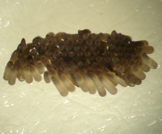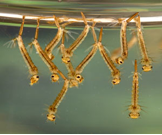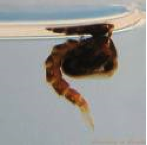Mosquito Biology
The mosquito goes through four separate and distinct stages of its life cycle: Egg, Larva, Pupa, and Adult. During each stage of its life cycle, the mosquito looks distinctly different than any other life stage. This is known as a complete metamorphosis and each stage can be easily recognized by its unique appearance.

Egg:
Female mosquitoes deposit eggs in varying ways. They prefer water sheltered from the wind by grass and weeds. The females carefully select the site according to temperature, salinity and oxygen level. Some species will lay egg that float on the water surface of stagnant water. The eggs of Anopheles are laid singly on the water surface and are readily recognized by their canoe like shape and the pair of floats on either side. The eggs of Culex, Culiseta, Coquillettidia and Mansonia mosquitoes are laid side by side and stick together to form rafts which float on the surface. A raft of eggs looks like a speck of soot floating on the water and is about 1/4 inch long and 1/8 inch wide. Each raft may contain from 100 to 400 eggs. The water may be in tin cans, barrels, horse troughs, ornamental ponds, swimming pools, puddles, creeks, ditches, catch basins or marshy areas. These eggs float on the water surface until they hatch. Anopheles, Culex, Culiseta, Coquillettidia and Mansonia eggs are susceptible to long periods of drying out.
Ochlerotatus and Aedes, as well as many other genera, do not make egg rafts, but lay their eggs singly, usually on damp soil. Eggs will eventually be submersed (salt water high tides, irrigated pastures, treeholes flooded by rains, flooded stream bottoms) and be allowed to hatch. Some species have eggs that can lie dormant (not submersed in water) for many years until they are finally covered with water and then they will hatch. Eggs of different species of mosquitoes might withstand subzero winters before hatching.
The embryo in the egg completes development in one to two days dependent on temperature. In those eggs laid in water the embryo emerges almost in unison as a first instar larvae and commences larval development. However in those species which have drought resistant eggs the embryo remains in the egg until next it is flooded, when the egg hatches.

Larva:
Mosquito larvae (plural of larva), commonly called “wigglers,” live in water from 4 to 14 days (or longer) depending on water temperature. Larvae are not evenly distributed in the breeding site, tending to concentrate in areas where they will gain most shelter from predators. Shallow pool fringes, particularly if grassy, provide protection from predators.
They come to the surface at frequent intervals to obtain oxygen through a breathing tube (called a siphon) breaking the water surface tension. Most species have specialized breathing siphons at the ‘tail’ end of their bodies. Anopheles larvae have breathing openings along their abdomen. They do not have a siphon and lie parallel to the water surface to get a supply of oxygen through a breathing opening. Coquillettidia and Mansonia larvae attach to aquatic plants to obtain their air supply (breathe through the plants stalks). However, most larvae have siphon tubes for breathing and hang upside down from the water surface.
The larvae feed on microorganisms and organic matter in the water filtering food with their specialized mouthparts. They are constantly feeding since maturation requires a huge amount of energy and food. They hang with their heads down and the brushes by their mouths filtering anything small enough to be eaten toward their mouths to nourish the growing larvae. They feed on algae, plankton, fungi and bacteria and other microorganisms. One mosquito species larva feeds on larvae of other mosquitoes: Toxorhynchites, the largest mosquito known, are predators of other mosquito larvae sharing their habitat. Their larvae are much larger than other mosquito larvae. They have specially modified heavily chitinized mouthparts, which allow them to seize other mosquito larvae and to eat them.
During the growth process, larvae shed (molt) their skins four times, growing larger after each molt. Each molt is known as an instar. At the 4th instar, the usual larva reaches a length of almost 1/2 inch and toward the end of this instar ceases feeding. When the 4th instar larva molts, it becomes a pupa.

Pupa:
Pupae (plural of pupa) or “tumblers” also live in the water. The pupae are lighter than water and therefore float at the surface. The pupal stage is a resting, non-feeding stage of development, but pupae are mobile, responding to light changes. When disturbed, they dive in a jerking, tumbling motion toward protection and then float back to the surface. They swim with a rapid tumbling action propelled by flexing its extensive tail, which contains the abdomen of the developing adult.
Instead of a single siphon tube for breathing (like most larvae) pupae have two siphon tubes, that are now located on the back of the “head” of the pupa. These are known as ‘trumpets.’
The pupae do not eat or go through a molting process. They only breathe air and change inside their casing. The stage is one when the larval tissue is reorganized to form an adult insect. This process is similar to the metamorphosis seen in butterflies when the butterfly develops – while in the cocoon stage – from a caterpillar into an adult butterfly. The adult mosquito grows inside the pupa and in two days or so, when it is fully developed, it splits the pupal skin and emerges to the surface of the water to complete its life cycle or metamorphosis. Mosquito pupae live in water from 1 to 4 days, depending upon species and temperature.

Adult:
After breaking free of the pupal skin, the adult will rest on the water surface for a brief period of time to allow its body and wings to dry and harden. The wings have to spread out and dry properly before it can fly.
Different species will have different characteristics and behaviors. This affects things like; active time period (e.g., daytime or nighttime biters), how far they fly from their hatching source, what types of animals they “prefer” to bite (Example; some prefer birds over mammals) and other factors.
Blood feeding and mating does not occur for a couple of days after the adults emerge. Only female mosquitoes require a blood meal and some species are very selective and will only feed on a particular vertebrate species; others will feed on almost any warm-blooded animal, while others specialize on lizards and frogs. A number of species can produce a limited number of eggs without taking a blood meal, relying on the food reserves from the larval stage to provide the protein required for egg development. Male mosquitoes do not bite, but both male and female mosquitoes rely on plant nectar and plant juices to supply the carbohydrates needed to provide the energy required for flight and other activities. Stimuli that influence biting (blood feeding) include a combination of carbon dioxide, temperature, moisture, smell, color and movement.
Behavioral patterns:
Mosquito species can be categorized as:
Diurnal – active during the day
Crepuscular – peaks of activity at dawn and dusk
Nocturnal – active during the night
Aedes and Ochlerotatus mosquitoes are painful and persistent biters. They search for a blood meal early in the morning, at dusk (crepuscular feeders) and into the evening. Some are diurnal (daytime biters) especially on cloudy days and in shaded areas. They usually do not enter dwellings, and they prefer to bite mammals like humans. Aedes and Ochlerotatus mosquitoes are strong fliers and are known to fly many miles from their breeding sources.
Culex mosquitoes are painful and persistent biters also, but prefer to attack at dusk and after dark. They readily enter dwellings for blood meals. Domestic and wild birds usually are preferred over man, cows, and horses. Culex mosquitoes are generally weak fliers and do not move far from home, although they have been known to fly up to two miles. Culex females usually live only a few weeks during the warm summer months. Those females that emerge in late summer search for sheltered areas where they “hibernate” until spring. Warm weather brings them out again in search of water on which to lay their eggs.
Culiseta mosquitoes are moderately aggressive biters, attacking in the evening hours or in the shade during the day. Psorophora, Coquillettidia and Mansonia mosquitoes are becoming more pestiferous as an ever-expanding human population invades their natural habitats. Anopheles mosquitoes are persistent biters and are the only mosquitoes which transmit malaria to man.
Host Finding:
There are several stages in the feeding behavior of mosquitoes – activation, orientation, landing and probing. The time of activation is set by the insect’s biological clock but will be modified by climatic influences (if it is too windy, too cold or if the humidity is too low). The activity is often triggered by CO2, with the insect finding the host by flying up the odor plume generated by the host (CO2 + body odors). The range of attraction is to be approximately 20 meters with a visual range of 7 meters or less. The final stages of landing and feeding require the visual cues of color and shape as well as the odor plumes. None of the traps devised to attract the animal using CO2, light, heat and various chemicals is as attractive as the intact animal.
Reproduction:
Females need only mate once but often mate more frequently. On mating, the sperm in the form of a sperm plugs are transferred into the vagina of the female; then migrate to the spermathecae where they are stored until required. When the female is ovipositing, the sperm enters the egg as it passes down the genital tract. One mating provides enough sperm to last the insect’s lifetime.
In some species males form a swarm and the females fly into the swarm where they couple with a male. In some species, mating takes place on the host vertebrate shortly after the female takes a blood meal. Male mosquitoes normally emerge 24 hours prior to the females.
